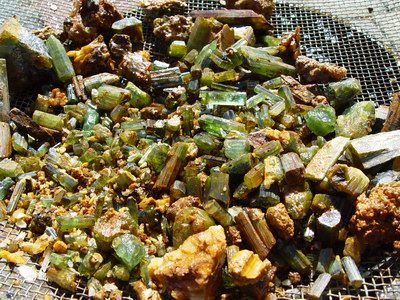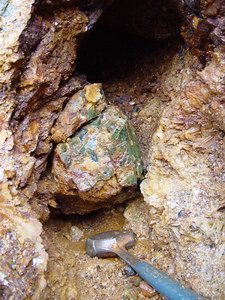Oxford County, Maine
Coromoto Minerals
The 2004 Season at Mt. Mica
---- May -----

A screen load of tourmaline and other minerals from Pocket 7
Coromoto Minerals
The 2004 Season at Mt. Mica
---- May -----

A screen load of tourmaline and other minerals from Pocket 7
| Continued from page 1: As we continued to work the pocket 7 (MMP7-04), we could detect a narrow space that seemed to be going down. Each of us took many turns at groping inside of this space. It seemed for a time that this might be the bottom of the pocket . There felt to be, as our senses where confined to our finger tips, a  large lump in the back. We use a garden hose connected to either our 2"
gasoline pump run on idle or to our electric pump as our primary
digging and exploring tool. However, no matter how much we blindly
washed into this cavity or scratched and pawed with our fingers, we
could not seem to move this piece in the slightest. Perhaps it was just
a feldspar plate attached to the pocket wall. It would be
unlikely
though that this would be the bottom as we were still several feet
above the garnet zone. Generally pockets at Mt.Mica extend down to the
'garnet line' where they end in a layer of cleavelandite with a few
cassiterites mixed in. In the image Mary again shows excellent
'form and technique' as she had her go at finding something. Richard is
obviously amused. So once we reached a point of diminishing
returns, I decided to test the depth of
the pocket by drilling the 'floor' with our small pneumatic hammer. So
as Frank Perham grimaced and worried that I might perforate some
important speciemn , I gingerly drilled the floor. The drill worked its
way into the bottom for a few inches and then dropped into an unseen
cavity below.
large lump in the back. We use a garden hose connected to either our 2"
gasoline pump run on idle or to our electric pump as our primary
digging and exploring tool. However, no matter how much we blindly
washed into this cavity or scratched and pawed with our fingers, we
could not seem to move this piece in the slightest. Perhaps it was just
a feldspar plate attached to the pocket wall. It would be
unlikely
though that this would be the bottom as we were still several feet
above the garnet zone. Generally pockets at Mt.Mica extend down to the
'garnet line' where they end in a layer of cleavelandite with a few
cassiterites mixed in. In the image Mary again shows excellent
'form and technique' as she had her go at finding something. Richard is
obviously amused. So once we reached a point of diminishing
returns, I decided to test the depth of
the pocket by drilling the 'floor' with our small pneumatic hammer. So
as Frank Perham grimaced and worried that I might perforate some
important speciemn , I gingerly drilled the floor. The drill worked its
way into the bottom for a few inches and then dropped into an unseen
cavity below. Now that we knew we were just dubbing around on the top of the pocket our next move was to open it more. We drilled a series of holes around what we believed to be the periphery of the pocket trying to 'sound' its dimensions. Once we had an idea of the margins we could take the gamble  and
carefully use a small amount of explosives to open the pocket. This is
a risky business and I take it upon myself alone to decide this
move. Although there is no shortage of ideas, my feeling is that
if a major specimen is going to be destroyed, better to do it myself.
As I tell people, if I follow your advice and it goes wrong, I'll be
mad at you for giving it to me, I'll be mad at myself for accepting it,
and you'll feel bad for giving it. If I call the shot and it goes bad,
I'll be mad at myself and you'll have the pleasure of the ' I told you
so's'. In my business life I frequently tell people I don't mind making
decisions and in fact I don't even mind making an occasional bad
decision. Its just the ratios that count. So, what we have been doing
all along to hedge our bets and shift the ratios, is to drill to the
lower contact. By doing this, the charge, if sufficient care is taken,
is actually beneath the garnet line and the pocket zone above is lifted
by the blast. The odds of a direct hit into a pocket are somewhat
diminished. That's the theory anyway. The down side of this extra drilling is the generation of
more muck. So once we felt we knew the approximate location of
the pocket, we loaded two holes on either side of its presumed loaction and
somewhat in front of it. Then we prayed or I did anyway. and
carefully use a small amount of explosives to open the pocket. This is
a risky business and I take it upon myself alone to decide this
move. Although there is no shortage of ideas, my feeling is that
if a major specimen is going to be destroyed, better to do it myself.
As I tell people, if I follow your advice and it goes wrong, I'll be
mad at you for giving it to me, I'll be mad at myself for accepting it,
and you'll feel bad for giving it. If I call the shot and it goes bad,
I'll be mad at myself and you'll have the pleasure of the ' I told you
so's'. In my business life I frequently tell people I don't mind making
decisions and in fact I don't even mind making an occasional bad
decision. Its just the ratios that count. So, what we have been doing
all along to hedge our bets and shift the ratios, is to drill to the
lower contact. By doing this, the charge, if sufficient care is taken,
is actually beneath the garnet line and the pocket zone above is lifted
by the blast. The odds of a direct hit into a pocket are somewhat
diminished. That's the theory anyway. The down side of this extra drilling is the generation of
more muck. So once we felt we knew the approximate location of
the pocket, we loaded two holes on either side of its presumed loaction and
somewhat in front of it. Then we prayed or I did anyway.After the fumes cleared, we came down into the pit to assess the damage.  We
were lucky this time as we had just blown the front off of the pocket
exposing a 3' thick layer of pocket material. ( see image above) After
setting up our ' hydraulic excavator' ( garden hose), we began carefully
to wash some of the pocket mud at the front. Within a few minutes we
had identified our lump. It was a huge crudely formed tourmaline
immediately dubbed the ' bowling ball'. The tourmaline had wedged itself
in the top of the pocket creating what seemed to be the bottom as we had worked it from above. After
struggling for awhile we were able to remove this specimen. Excepting
it's size, it wasn't much to look at. Many sections of it's
termination were spawled off. We collected as much of these as we could
to try for later rehabilitation in the laboratory. We continued to work at the pocket by
exploring the top layer of debris as far back as we could. By the
end of the day we could insert the hoe handle all the way in and still
not touch 'terra firma'. This was a big pocket that apparently had the
ability to make big tourmalines.....the little gears inside our heads
whirred at a feverish pace imagining what mineral cornucopia was
contained under all that debris. So far in this chamber we had only
found the Bowling Ball. Unfortunately, it was getting late and it was
time to button this pocket up. Some time back our Mack dump truck
had decided to sluff off it's tailgate bringing the hinge points with it.
So with the heavy tailgate covering the pocket, huge boulders stacked
in front and water rising into the pit, we felt comfortable in leaving
for the night. In addition, a former Rumford police officer would be
providing extra security. We
were lucky this time as we had just blown the front off of the pocket
exposing a 3' thick layer of pocket material. ( see image above) After
setting up our ' hydraulic excavator' ( garden hose), we began carefully
to wash some of the pocket mud at the front. Within a few minutes we
had identified our lump. It was a huge crudely formed tourmaline
immediately dubbed the ' bowling ball'. The tourmaline had wedged itself
in the top of the pocket creating what seemed to be the bottom as we had worked it from above. After
struggling for awhile we were able to remove this specimen. Excepting
it's size, it wasn't much to look at. Many sections of it's
termination were spawled off. We collected as much of these as we could
to try for later rehabilitation in the laboratory. We continued to work at the pocket by
exploring the top layer of debris as far back as we could. By the
end of the day we could insert the hoe handle all the way in and still
not touch 'terra firma'. This was a big pocket that apparently had the
ability to make big tourmalines.....the little gears inside our heads
whirred at a feverish pace imagining what mineral cornucopia was
contained under all that debris. So far in this chamber we had only
found the Bowling Ball. Unfortunately, it was getting late and it was
time to button this pocket up. Some time back our Mack dump truck
had decided to sluff off it's tailgate bringing the hinge points with it.
So with the heavy tailgate covering the pocket, huge boulders stacked
in front and water rising into the pit, we felt comfortable in leaving
for the night. In addition, a former Rumford police officer would be
providing extra security.The next day, Friday, May 14, we continued to work the pocket. This pocket was exceedingly rusty so the visual delights in discovery of its contents was somewhat hampered. For me, seeing an important specimen freshly exposed but still lying in place is a rare treat and is to be savored slowly. Working the pocket with a garden hose has greatly increased the number of these quality experiences. So far, as we worked the pegmatite this year, we had only green tourmaline. This day our hosing though would uncover a color zoned tourmaline for which Mt. Mica is famous. Like most Mt. Mica tourmalines, this one, although quite large, was broken into countless fragments. To borrow from A.C Hamlin's style, it appeared that nature, in a fit of rage, smashed the crystal. On a less melodramatic note there is a tendency for the the tourmaline at Mt. Mica to part along color transitions. For example tourmalines that are black at the base frequently part at the transition to green. Occasionally, after the separation, the crystal continues to grow or heal. Hence, this fragmentation may not occur during 'pocket ruptures' as it is doubtful the environment necessary to foster additional growth would be preserved after such an event.
|
||